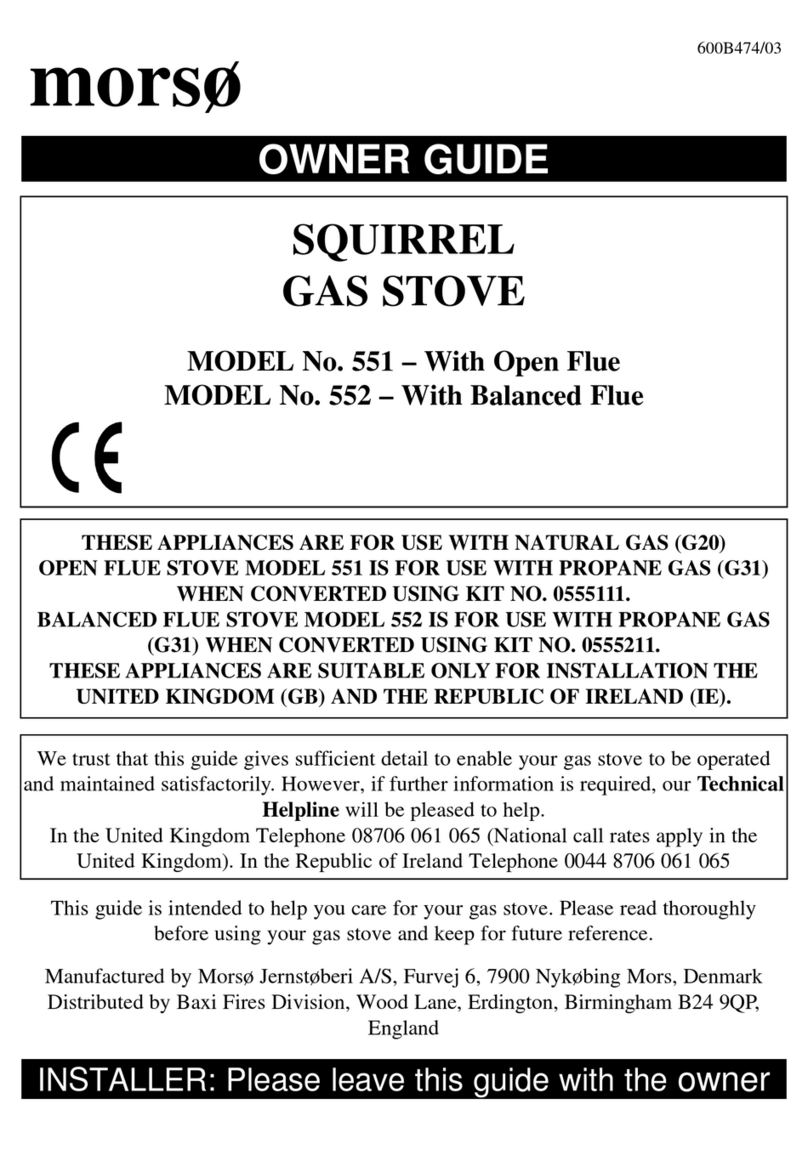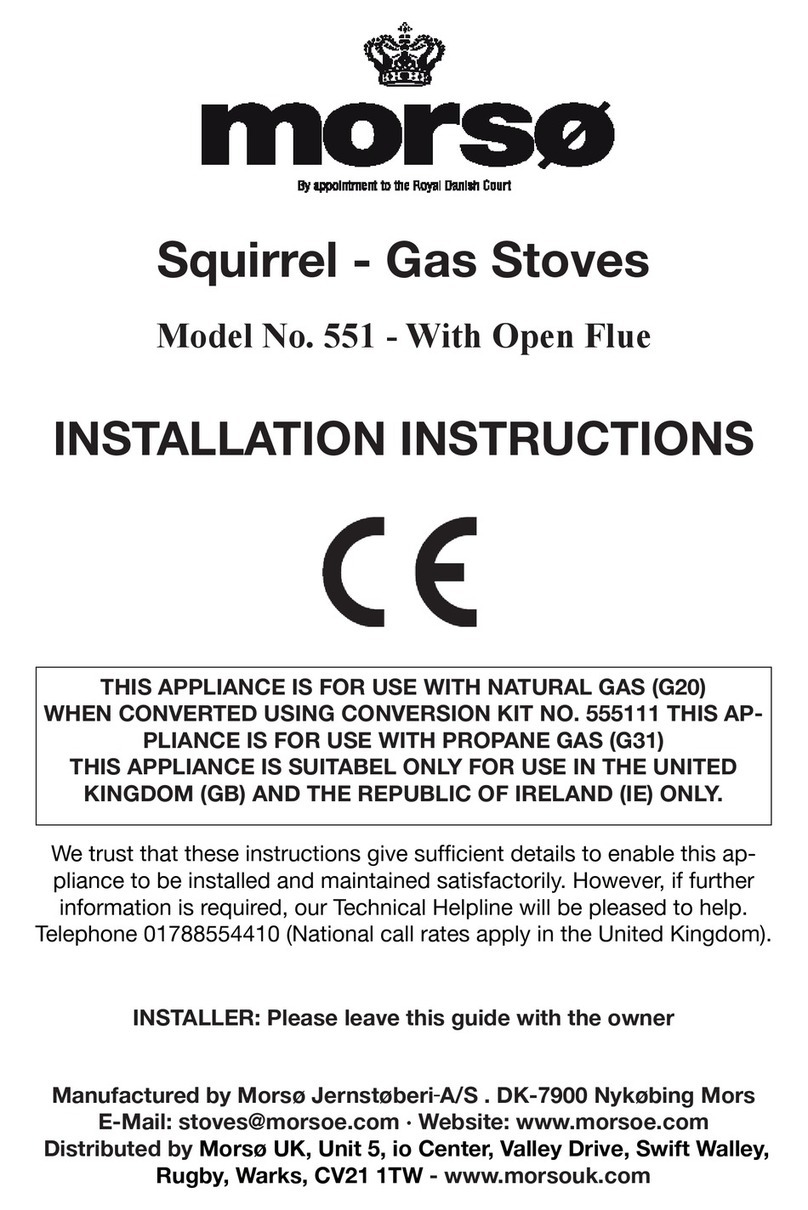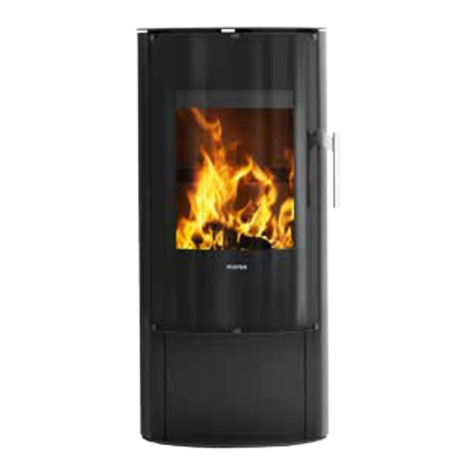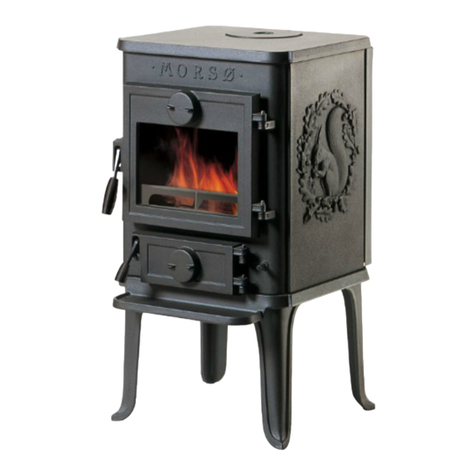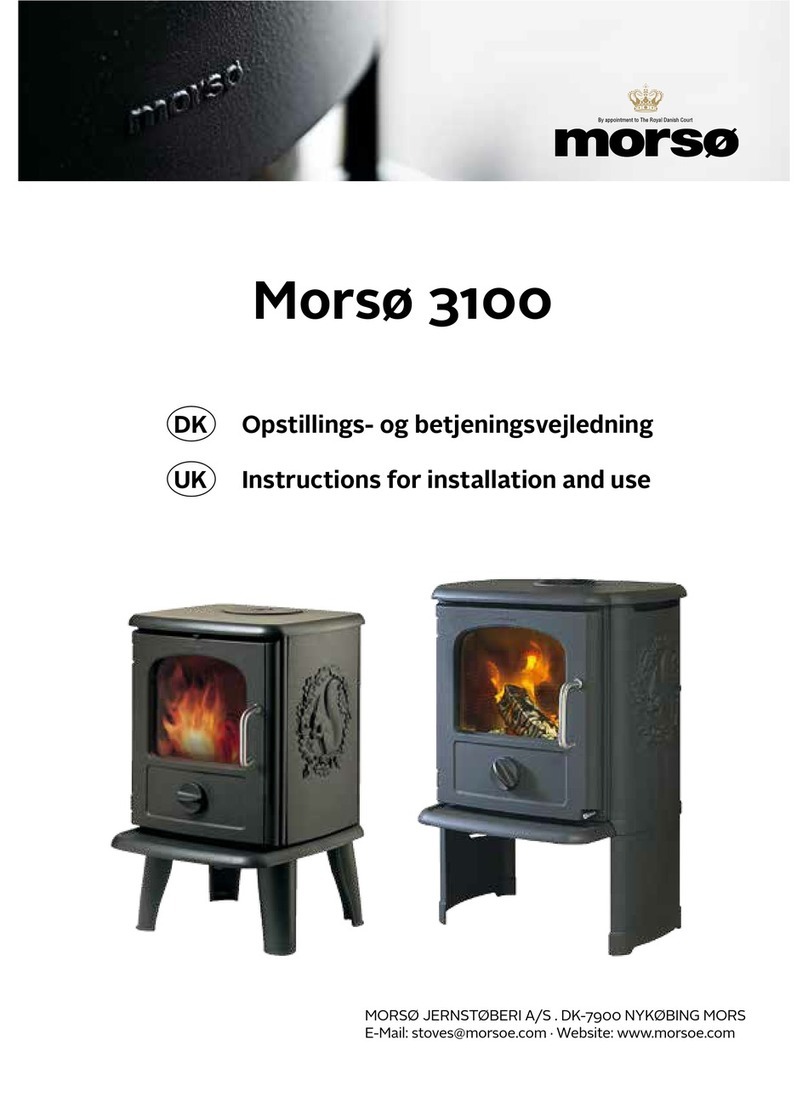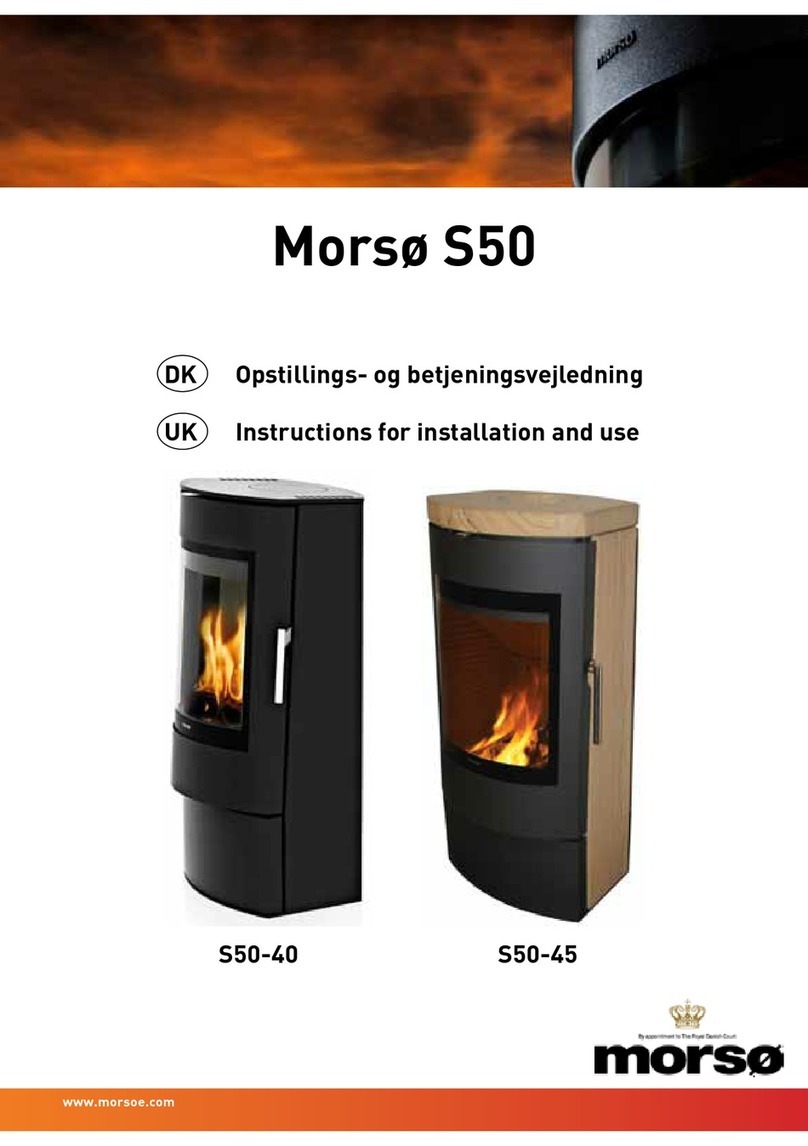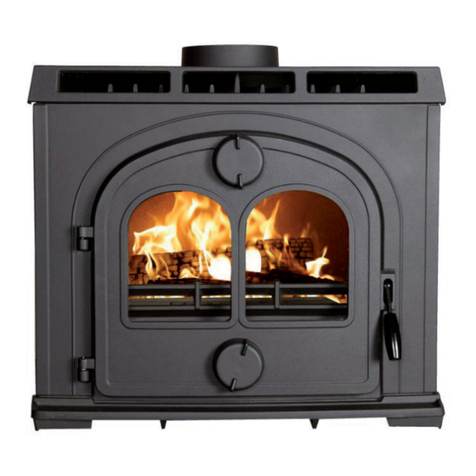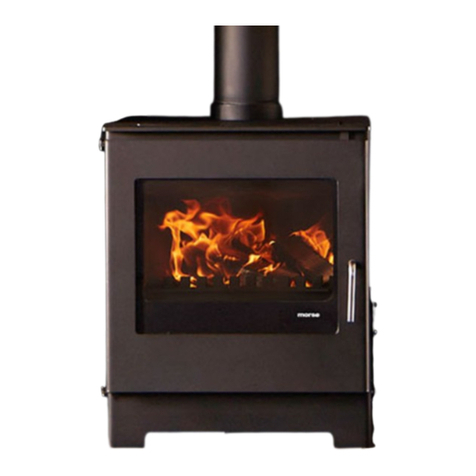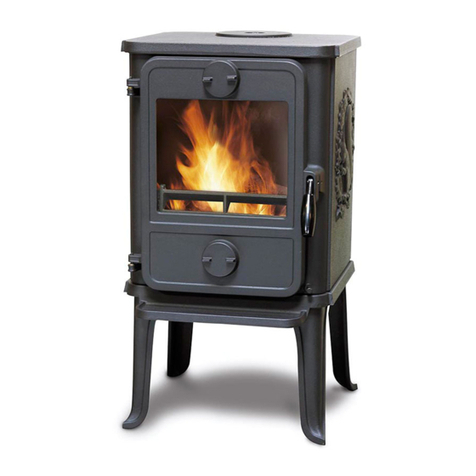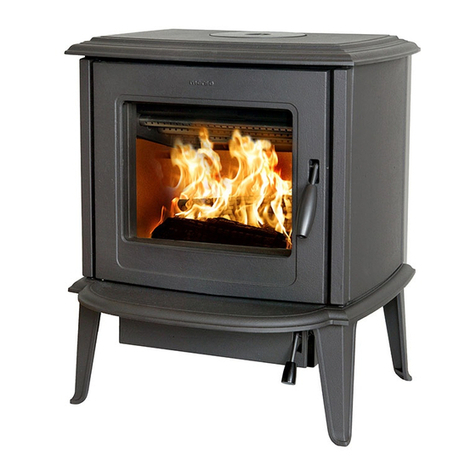
16
17
DK ENG 1. Lift the door o the hinges and place it face down on a sheet of cardboard or other non-
abrasive fabric.
2. Unscrew the ve bolts that secure the glass. (In the event that a bolt sheers o when being un-
screwed, remove the remaining body of the bolt by drilling down its cnetre with 1/8 inch high
speed steel drill bit. Smaller drill bits may be successful, but do not use a lager bit. Make sure
the bit stays away from the edges of the bolt - this may damage the thread in the cast iron).
3. Remove the old ceramic gaskets and clean up the surface underneath with wire wool or
emery paper to remove loose particles.
4. Place the new gasket material in position around the perimeter of the window area, making
sure to pinch them to the length in such a way that they make a continuous seal. Leave no gaps.
5. Place the new glass in position on the strips and screw home the fresh bolts and tting
by hand.
6. Finally, give each of the bolts an extra half turn or so. The glass should held tight enough
by that cleaning will not dislodge it. Do not over-tighten the bolts as this may put exces-
sive pressure on the glass, resulting in cracking - important!
To reduce the risk of breaking the glass, avoid striking the glass or slamming the door.
Internal service parts
The ame-path equipment - consisting of the ashpan, grate, rebricks, Cast iron re plates, glass,
bae and ue collar - are subject to the extremes of heat produced by the re. From time to time,
one or other of these parts may need replacing as a matter of routine maintenance.
NOTE: The ame-path equipment, the ceramic rope and the paint nish are not
covered by guarantee.
All of these service parts can be bought from your Morsø dealer, and we recommend that
damaged parts are replaced as soon as possible to avoid collateral damage.
The grate may be replaced by lifting it by its left hand edge and twisting it backwards. Dis-
locate the riddling arm from the grate by feel from beneath the oor of the rebox. If you
nd this dicult for any reason, raising the rectangular grate surround casting may help.
Should the bae be distorted by an overre, the stove will still function, although its eciency
may be compromised. Replace it as soon as possible. The rear casing is removed (four bolts).
Remove these and withdraw the bae from the rebox (this may be easier if the rebricks are
rst removed).
Before replacing the bae, scrape out the old re furnace and replace with new to make
an eective seal.
Reasons for fast internal wear and tear
- Persistent heavy ring
- Soot and ashes left to accumulate
Ceramic Gasket
The gasket around the perimeter of the door may harden over a period of time. It should be
replaced if it becomes dicult to close the door or if air starts to leak in around the perim-
eter of the door, causing the re to become a little less controllable. A Morsø rope gasket
kit is available from your stove supplier.
3.3 Cleaning the Stove and the Flue
Check for soot above the bae plate and around the ue outlet every month or so to start
with. If the stove suddenly becomes sluggish, check for a soot fall around the ue collar or
in the ue/chimney. - at least once a year. Inspect every month.
Clean the ue/chimney - all the way from the stove to the ue terminal point above the house.
A good routine is to clean the ue after each heating season in any case, and inspect prior
to the season to ensure that bird’s nests or other blockages have not ocurred during the
o season.
Ash disposal
Empty the ashpan on a daily basis or as needed. Ash allowed to build up towards the under-
side of the grate will trap heat and could cause premature failure of the grate.
Empty the ashpan according to this procedure:
When the door is closed, the grate can be operated by means of the riddling bar. Open the
front door, and use a shovel or poker to stir excess ash through the ash slots in the grate
down into the ash pan. Remove the ash pan, making sure to keep it level.
Dispose the ash in a metal container with a tight tting lid.
The closed container of ashes should be placed on a noncombustible oor or on the ground,
well away from all combustible materials, pending nal disposal. If the ashes are disposed of
by burial in soil or otherwise locally disperded, they should be retained in the closed container
until all cinders have thoroughly cooled.
Return the ash pan to its original position in the stove, and close.
Caution:
Never empty a stove in operation.
Never use your household or shop vacuum cleaner to remove ash from the stove;
Always remove and dispose of the ash properly.
Creosote - formation and need for removal
When wood is burned slowly, it produces tar and other organic vapors, which combine with expelled
moisture to form creosote. The creosote vapors condense in the relatively cool chimney ue of a slow-
burning re. As a result, creosote residue accumulates on the ue lining. When ignited this creosote
makes an extremely hot re. When burning wood, inspect the chimney connector periodically to de-
termine if a creosote buildup has occurred.
Chimney sweeping
Inspect the system regularly during the heating season as part of a regular maintenance sched-
ule. To inspect the chimney, let the stove cool completely. Then, using a mirror, sight up through
the ue collar into the chimney ue. If you cannot inspect the ue system in this fashion, the
stove must be disconnected to provide better viewing access.
Clean the chimney using a brush the same size and shape as the ue liner. Run the brush up
and down the liner, causing any deposits to fall to the bottom of the chimney where they
can be removed through the clean-out door.

